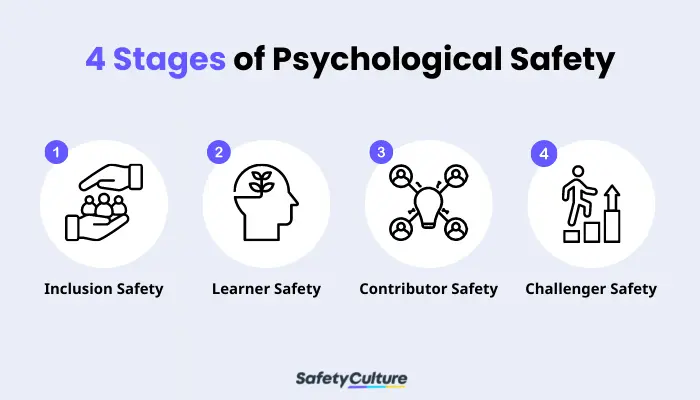What is Psychological Safety?
Psychological safety means the feeling of being able to openly speak up and being true to oneself without fear of facing negative consequences on one’s image, career, or status. Hence, psychological safety in the workplace is the ability to foster a shared sense and culture of empowering individuals to express ideas, raise concerns, and ask questions without unnecessarily feeling afraid to experience an unfavorable impact from their team.
Why is Psychological Safety at Work Important?
Here are a few reasons why mental safety at work should not just be an emerging trend but should be one of the main components of an organization’s priority efforts toward a culture of safety.
Employee Support
Workplace violence doesn’t only pertain to physical, verbal, and other commonly recognized means of harm or posing risks to people in the workplace. Any disruptive behavior that can also affect one’s mental and psychological well-being must also be equally considered. This leads to a comprehensive workplace safety program.
On the other hand, times of crisis (e.g., global health concerns and socio-political events) can also have a direct or indirect impact on a worker’s psychological state. Feelings of isolation, helplessness, and a lack of or no control over things happening simultaneously are some of the most common challenges and triggers for many. Since one’s psychological state can also affect the body, being under stress due to this condition can cause anxiety, loss of focus, decreased productivity, sickness, and burnout.
Another key practice in ensuring psychological safety is diversity and inclusion in the workplace. As more and more organizations continue to recognize their importance, it goes hand in hand with psychological safety as it helps foster a space to openly call out inequality and various forms of injustice that happen to employees and team dynamics. Also, not being able to reassure employees that their ideas are valued can stall the growth of the business in the short and long term.
It’s also essential to recognize that many organizations in various industries (e.g., oil and gas, healthcare, and aviation) employ lone workers. According to a report by TracPlus as cited by WorkCare, there are around 53 million lone workers globally, almost half of them in the US. The study also found that having strict safety protocols in place isn’t enough to establish efficient ways of communication. This, in turn, impacts their psychological safety. Mobile apps like SHEQSY by SafetyCulture help empower lone worker safety, let remote employees stay connected, and feel psychologically safe when at work.
In these cases, it’s needless to say that the employer’s role is to establish and implement policies on how to feel psychologically safe in the workplace.
Productivity and Business Impact
The two most important elements of building and attaining an organization’s psychological safety are trust and respect. Without these, employers may face the risk of being unable to sustain a culture and workplace equipped to make workers feel their psychological safety is prioritized.
According to a two-year study conducted by Google, one of the most important components of high-performing teams is psychological safety. In fact, it serves as a solid foundation for the other components to be fully realized.
In relation to that, a poor level or a lack of psychological safety at work can translate into negative consequences a business may face. Workers who don’t feel safe speaking up and sharing their thoughts and ideas can be a loss for the company in various ways, including the following:
- Being unable to pinpoint risks and loopholes in current systems and processes can lead to lost opportunities for improvement.
- Failing to recognize the need to empower everyone to share their suggestions and objections can result in building a culture of constant rejection.
Benefits
What’s in it for an organization to build a psychologically safe space for its employees? The benefits of psychological safety in the workplace include the following:
- Enhanced employee engagement
- Inclusive culture
- Improved creativity
- Greater collaboration
- Better employee well-being
- Reduced employee turnover
- Increased level of team performance
The 4 Stages of Psychological Safety in the Workplace
When talking about and dealing with psychological safety, it’s important to remember that taking it one stage at a time helps more in building a more sustainable culture toward workplace psychological and psychosocial safety. Besides, it can be taxing both for employers and workers to achieve full-blown psychological safety without properly setting the foundation for each of its stages.
Following that narrative, being psychologically safe starts with the feeling of belonging and then progressing into the natural flow of their learning and growth, making a difference, and challenging ideas to produce better solutions. Getting buy-in from leaders and managers is also a great practice in ensuring employees go through the stages of psychological safety in a way that works for them. The organization must be able to recognize the fact that each employee has unique pacing when it comes to reaching their psychological safety in the workplace.
Here are some psychological safety examples under the 4 stages employees must go through to help them become confident and free in making valuable contributions to their own growth, their teammates, and the organization:

4 Stages of Psychological Safety
Stage 1: Inclusion Safety
Connection and Belonging
This stage deals with the process of satisfying humans’ basic need for connection and belonging. Employees in this stage feel confident and accepted for their personality and characteristics, letting them feel safe to be themselves.
A belonging and inclusive culture is established from the hiring and onboarding processes through introductions, personal story sharing, and continued avenues to connect, such as teambuilding activities, social time, and sharing the acceptance of each person’s unique characteristics.
Stage 2: Learner Safety
Learning and Growth
Workers in the second stage of psychological safety feel safe in actively engaging in the overall experience of learning. This is evident in the way they ask questions, provide and receive feedback, try out various activities, and acknowledge mistakes in the process.
Fostering a culture where employees are involved in freely speaking of their experiences and shortcoming in a team training environment helps ensure that learning and growth are part of an organization’s psychological safety.
Stage 3: Contributor Safety
Making a Difference
The third stage is where the need to inspire and create impacting differences is fulfilled. Workers are more empowered to maximize their skills in contributing to the organization in a way that’s of high value and has a lasting impact.
An example of this stage is involving employees in the creation of training from a front line worker perspective on how the work is really getting accomplished. Employees can also help write standards or create training programs.
Stage 4: Challenger Safety
Making Things Better
Lastly, workers in the final stage of psychological safety feel safe to challenge the current system and identify opportunities for continuous improvement. Hence, this stage allows for the ultimate goal of addressing the need to strive for betterment in the bigger picture.
This stage pertains to workers who feel safe to challenge current policies and procedures and voice out their suggestions on how tasks and systems can be safer and more effective from their perspective and for the benefit of the organization.
Create Your Own Psychological Safety Survey “
Eliminate manual tasks and streamline your operations.
Get started for FREECreating a Psychologically Safe Workplace
Whose responsibility is it to lead the way in ensuring the workplace fosters and practices a culture of holistic safety? While the majority of the legwork is carried out by the employer most of the time, a great deal of effort also comes from the employees themselves toward creating psychological safety in the workplace.
- Make it a priority.
- Implement it as a mindset rather than a one-time event thing.
- Encourage a culture of speaking up through the principle of respect.
- Practice operating by trust.
- Be open to giving and receiving feedback.
- Recognize employee individuality.
- Create and maintain programs on training in psychological safety.
What is psychological safety training?
It refers to the practice or initiative of proactively creating a culture or environment where everyone feels safe and comfortable speaking up. Since getting everyone across the organization aligned with the policies and guidelines revolving around this may take time, it helps to implement effective training programs and solutions to make the process manageable and fun.
Deliver the learning experience your team deserves by developing better ways of training them. Mobile learning solutions like Training help you do just that and more. Check out these courses that you can download, deploy, and edit:
- Mental Health in the Workplace
- Supporting Someone in Crisis
- Bullying and Harassment
- Diversity and Inclusion
Explore the Course Library for more
Evaluating Psychological Safety
Learn about some of the most common signs you should pay attention to when conducting a psychological safety assessment in your organization:
- Mistakes are treated as learning opportunities.
- Continuous learning is strategic.
- Performance reviews are conducted toward constant improvement.
- Everyone is encouraged to take risks rather than stay in one’s comfort zone.
- The nature of thoughts and ideas being shared by employees is diverse.
Considering these signs, there are available tools you can use in conducting objective evaluations. These include psychological safety surveys, questionnaires, and other similar forms to collect feedback and information from employees based on their experiences in the workplace. You can also benchmark and set an ideal scoring system to identify areas for improvement and see which aspects of your initiatives are working.
FAQs About Psychological Safety
Emotional safety refers to the feeling of security and willingness to express how you really feel. Psychological safety, on the other hand, is more complex yet still closely related to it. It pertains to the overall feeling and ability to speak up without the fear of facing negative repercussions in terms of image, status, or even career.
As mentioned earlier in this article, the two most important elements of building psychological safety are trust and respect. It’s also not trust vs psychological safety—one must exist first before the other one is achieved. Hence, trust must be established first before an organization attains and maintains a psychologically safe workplace for everyone.
A psychologically safe team has members who aren’t afraid to pinpoint areas that can be improved, ask questions, and suggest ideas to make processes better. They’re empowered to take the initiative and aren’t threatened by surrounding forces. Also, they operate by trust, remain open-minded, and be more creative in their work.
Some of the consequences that an organization can face as a result of unimproved psychological safety among its employees are the following:
- Decrease in productivity level
- Low employee morale
- Averting risks, hence affecting one’s ability to take initiative
- Feeling they’re not included in important decision-making processes



